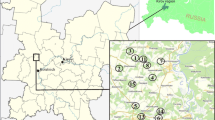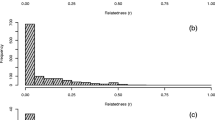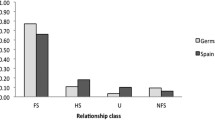Abstract
Kinship amongClethrionomys rufocanus was investigated during the winter of 1992/93 in a 3-ha enclosure using both molecular and catch-mark-release techniques. Forty-six adult voles (22 males and 24 females) having high heterozygosities, which were collected from several natural populations, were released into the enclosure on 29 September 1992. Most fall-born individuals of both sexes stayed in their natal site during the non-breeding period (December–March), although reproductively active females dispersed during the fall breeding season (October–November). These philopatric individuals aggregated and formed an maternal family in the winter. Several females which failed to reproduce were solitary during this season. Some individuals which were derived from several families also aggregated into a mixed lineage group. Survival rate of fall-born voles from earlier litters was higher than that from later ones. Maternal families broke up soon after the onset of spring reproduction. Most females established a territory near the wintering site and made a kincluster, in which close relatives neighbored each other. Maternal families in winter bring about female kin-clusters in spring, which may influence reproductive output in the breeding season.
Similar content being viewed by others

References
Abe, H. (1976) Population structure and reproductive activity ofClethrionomys rufocanus bedfordiae (Thomas) in a wind shelterbelt of the Ishikari plain, Hokkaido.Journal of the Mammalogical Society of Japan 7: 17–30 (in Japanese with English summary).
Berteaux, D., J-M. Bergeron, D. W. Thomas and H. Lapierre (1996) Solitude versus gregariousness: do physical benefits drive the choice in overwintering meadow voles?Oikos 76: 330–336.
Bjornstad, O. N., S. Champely, N. C. Stenseth and T. Saitoh (1996) Cyclicity and stability of grey-sided voles,Clethrionomys rufocanus, of Hokkaido: spectral and principal components analyses.Proceedings of the Royal Society of London B 351: 867–875.
Bjørnstad, O. N., N. C. Stenseth, T. Saitoh and O. C. Lingjærde (1998) Mapping the regional transition to cyclicity inClethrionomys rufocanus: spectral densities and functional data analysis.Researches on Population Ecology 40: 77–84.
Boonstra, R., C. J. Krebs, M. S. Gaines, M. L. Johnson and I. T. M. Craine (1987) Natal philopatry and breeding systems in voles (Microtus spp.).Journal of Animal Ecology 56: 655–673.
Bujalska, G. (1975) Reproduction and mortality of bank voles and the changes in the size of an island population.Acta Theriologica 20: 41–56.
Dewa, H. (1975) Seasonal variation of daily activity rhythms in snow season.Research Bulletin of College Experimental Forests Hokkaido University 22: 105–120 (in Japanese with English summary).
Fujimaki, Y. (1969) The fluctuations in the number of small rodents.Bulletin of the Hokkaido Forest Experiment Station 7: 62–77 (in Japanese with English summary).
Getz, L. L., B. McGuire, T. Pizzuto, J. E. Hofmann and B. Frase (1993) Social organization of the prairie vole (Microtus ochrogaster).Journal of Mammalogy 74: 44–58.
Grodziński, W., M. Makomaska, R. Tertil and J. Weiner (1977) Bioenergetics and total impact of vole populations.Oikos 29: 494–510.
Hayes, J. P., J. R. Speakman and P. A. Racey (1992) The contributions of local heating and reducing exposed surface area to the energetic benefits of huddling by short-tailed field voles (Microtus agrestis).Physiological Zoology 65: 742–762.
Hayne, D. W. (1949) Calculation of size of home range.Journal of Mammalogy 30: 1–18.
Ims, R. A. (1987) Responses in spatial organization and behaviour to manipulations of the food resource in the voleClethrionomys rufocanus.Journal of Animal Ecology 56: 585–596.
Ims, R. A. (1989) Kinship and origin effects on dispersal and space sharing inClethrionomys rufocanus.Ecology 70: 607–616.
Ims, R. A. (1990) Determinants of natal dispersal and space use in grey-sided voles,Clethrionomys rufocanus: a combined field and laboratory experiment.Oikos 57: 106–113.
Ims, R. A. and H. P. Andreassen (1991) Does kinship influence space use and dispersal in male grey-sided voles?Oikos 62: 216–220.
Ishibashi, Y., T. Saitoh, S. Abe and M. C. Yoshida (1995) Polymorphic microsatellite DNA markers in the grey red-backed voleClethrionomys rufocanus bedfordiae.Molecular Ecology 4: 127–128.
Ishibashi, Y., T. Saitoh, S. Abe and M. C. Yoshida (1997) Sex-related spatial kin structure in a spring population of grey-sided volesClethrionomys rufocanus as revealed by mitochondrial and microsatellite DNA analyses.Molecular Ecology 6: 63–71.
Ishibashi, Y., T. Saitoh and M. Kawata (1998) Social organization of the voleClethrionomys rufocanus and its demographic and genetic consequences: a review.Researches on Population Ecology 40: 39–50.
Kalela, O. (1957) Regulation of reproduction rate in subarctic populations of the voleClethrionomys rufocanus (Sund.).Annales Academiae Scientiarum Fennicae, Series A IV, Biologica 34: 1–60.
Kawata, M. (1987) The effect of kinship on spacing among female red-backed voles,Clethrionomys rufocanus bedfordiae.Oecologia 72: 115–122.
Kawata, M. (1989) Growth and dispersal timing in male red-backed volesClethrionomys rufocanus bedfordiae.Oikos 54: 220–226.
Lambin, X. and C. J. Krebs (1991) Can changes in female relatedness influence microtine population dynamics?Oikos 61: 126–132.
Lambin, X. and C. J. Krebs (1993) Influence of female relatedness on the demography of Townsend’s vole populations in spring.Journal of Animal Ecology 62: 536–550.
Lambin, X. and N. G. Yoccoz (1998) The impact of population kin-structure on nestling survival in Townsend’s voles,Microtus townsendii.Journal of Animal Ecology 67: 1–16.
Madison, D. M. (1984) Group nesting and its ecological and evolutionary significance in overwintering microtine rodents. pp. 267–274.In J. F. Merritt (ed.)Winter ecology of small mammals. Carnegie Museum of Natural History, Pittsburgh.
Madison, D. M. and W. J. McShea (1987) Seasonal changes in reproductive tolerance, spacing, and social organization in meadow voles: a microtine model.American Zoologist 27: 899–908.
Madison, D. M., R. W. FitzGerald and W. J. McShea (1984) Dynamics of social nesting in overwintering meadow voles (Microtus pennsylvanicus): possible consequences for population cycling.Behavioral Ecology and Sociobiology 15: 9–17.
Mappes, T., H. Ylönen and J. Viitala (1995) Higher reproductive success among kin groups of bank voles (Clethrionomys glareolus).Ecology 76: 1276–1282.
Merritt, J. F. (ed.) (1984)Winter ecology of small mammals. Special Publication of Carnegie Museum of Natural History, Pittsburgh.
McGuire, B. and L. L. Getz (1995) Communal nesting in prairie voles (Microtus ochrogaster): an evaluation of costs and benefits based on patterns of dispersal and settlement.Canadian Journal of Zoology 73: 383–391.
McShea, W. J. (1990) Social tolerance and proximate mechanisms of dispersal among winter groups of meadow voles,Microtus pennsylvanicus.Animal Behaviour 39: 346–351.
Ostfeld, R. S. (1985) Limiting resources and territoriality in microtine rodents.American Naturalist 126: 1–15.
Ostfeld, R. S. (1990) The ecology of territoriality in small mammals.Trends in Ecology and Evolution 5: 411–415.
Petrusewicz, K., G. Bujalska, R. Andrzejewski and J. Gliwicz (1971) Productivity processes in an island population ofClethrionomys glareolus.Annales Zoologici Fennici 8: 127–132.
Petrusewicz, K., A. Górecki, W. Grodziński and J. Kozlowski (1983) Productivity and energetics.Acta Theriologica 28 Supplement1: 173–205.
Saitoh, T. (1987) A time series and geographical analysis of population dynamics of the red-backed vole in Hokkaido, Japan.Oecologia 73: 382–388.
Saitoh, T. (1989) Communal nesting and spatial structure in an early spring population of the grey red-backed vole,Clethrionomys rufocanus bedfordiae.Journal of the Mammalogical Society of Japan 14: 27–41.
Saitoh, T. (1995) Sexual differences in natal dispersal and philopatry of the grey-sided vole.Researches on Population Ecology 37: 49–57.
Saitoh, T., O. N. Bjørnstad and N. C. Stenseth (1998a) Densitydependence in voles and mice: a comparative study.Ecology (in press).
Saitoh, T., N. C. Stenseth and O. N. Bjørnstad (1998b) The population dynamics of the vole,Clethrionomys rufocanus, in Hokkaido.Researches on Population Ecology 40: 61–76.
Salvioni, M. and W. Z. Lidicker, Jr. (1995) Social organization and space use in California voles: seasonal, sexual, and age-specific strategies.Oecologia 101: 426–438.
Sambrook, J., E. F. Fritsch and T. Maniatis (1989)Molecular cloning: a laboratory manual, 2nd edn. Cold Spring Harbor Laboratory Press, New York.
Sera, W. E. and M. S. Gaines (1994) The effect of relatedness on spacing behavior and fitness of female prairie voles.Ecology 75: 1560–1566.
SPSS Inc. (1995)SPSS for Windows. Release 6.1.3. SPSS Inc., Chicago.
Stenseth, N. C., O. N. Bjørnstad and T. Saitoh (1996) A gradient from stable to cyclic populations ofClethrionomys rufocanus in Hokkaido, Japan.Proceedings of the Royal Society of London B 263: 1117–1126.
Stenseth, N. C., O. N. Bjørnstad and T. Saitoh (1998) Seasonal forcing on the dynamics ofClethrionomys rufocanus: modeling geographic gradients in population dynamics.Researches on Population Ecology 40: 85–95.
Stickel, F. (1954) A comparison of certain methods of measuring ranges of small mammals.Journal of Mammalogy 35: 1–15.
Viitala, J. (1977) Social organization in cyclic subarctic populations of the volesClethrionomys rufocanus (Sund.) andMicrotus agrestis (L.).Annales Zoologici Fennici 14: 53–93.
West, S. D. and H. T. Dublin (1984) Behavioral strategies of small mammals under winter conditions: solitary or social? pp. 293–298.In J. F. Merritt (ed.)Winter ecology of small mammals. Carnegie Museum of Natural History, Pittsburgh.
Wolff, J. O. (1985) Behavior. pp. 340–372.In R. H. Tamarin (ed.)Biology of new world Microtus. The American Society of Mammalogists, Special Publication No. 8.
Wolff, J.O. (1993) Why are female small mammals territorial?Oikos 68: 364–370.
Wolff, J. O. (1995) Friends and strangers in vole population cycles.Oikos 73: 411–414.
Wolff, J. O. and W. Z. Lidicker, Jr. (1981) Communal winter nesting and food sharing in taiga voles.Behavioral Ecology and Sociobiology 9: 237–240.
Ylönen, H., T. Mappes and J. Viitala (1990) Different demography of friends and strangers: an experiment on the impact of kinship and familiarity inClethrionomys glareolus.Oecologia 83: 333–337.
Ylönen, H., J. Pusenius and J. Viitala (1995) Impact of kinship and familiarity on the annual social organization and population dynamics ofClethrionomys andMicrotus voles.Annales Zoologici Fennici 32: 225–232.
Yoccoz, N. G., K. Nakata, N. C. Stenseth and T. Saitoh (1998) The demography ofClethrionomys rufocanus: from mathematical and statistical models to further field studies.Researches on Population Ecology 40: 107–121.
Author information
Authors and Affiliations
Corresponding author
Rights and permissions
About this article
Cite this article
Ishibashi, Y., Saitoh, T., Abe, S. et al. Kin-related social organization in a winter population of the voleClethrionomys rufocanus . Res Popul Ecol 40, 51–59 (1998). https://doi.org/10.1007/BF02765221
Received:
Accepted:
Issue Date:
DOI: https://doi.org/10.1007/BF02765221



